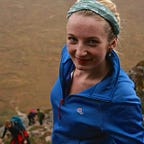Small
Last Friday, I decided to make the most of having a study day at home by going for a lunchtime run in the Pentland Hills, 20 minutes from my home in Edinburgh. I had been itching to get out to the Pentlands all week, longingly checking the West Kip webcam from the Mountain Weather Information Service, which gave me a tantalizing glimpse of hills blanketed with snow and a winter wonderland which has been so slow to arrive this year. There had been some snow melt by the time Friday arrived but enough still remained to give me the giddy excitement of a child with a sledge.
Setting off along the gently climbing road, I noticed how quickly the clouds were moving overhead and felt the push of wind on my back, urging me along. The weather had been stormy all week, with only a few days respite between back-to-back named storms, Ciara and Dennis. Leaving my house that morning though, I hadn’t really given much thought to the weather other than wearing the waterproof jacket, buff and gloves which are all but mandatory uniform when venturing out into the Scottish hills in winter. Nonetheless, the strength of the wind took me by surprise and, whilst I enjoyed its strong hand pushing me upwards as the path got ever steeper, a small niggle in the back of my mind reminded me that I would be facing into it on my return journey. What goes up must go down — and in the hills it’s rare to get weather which is always on your side.
Sure enough, as I reached the first summit and turned to run along the ridge, now side-on to the wind, it turned from helpful aid to a force to be reckoned with. Soon, the path turned downwards and I was facing fully into the wind, with nothing to break its descent down the valley until it hit me. Its ferocity took my breath away. Struggling to run downhill, slipping through deep snow drifts, a particularly big gust knocked me clean off my feet. I landed with a wet thump in the snow, gasping more with surprise than pain. The snow gave way beneath my hands as I tried to push myself back up. My feet sank further into the snow bank. I was floundering, pinned down by the roaring wind and unable to gain purchase in the crumbling snow. I stopped moving and looked around. Aside from a few sheep, chewing lazily on clumps of grass and looking distinctly unimpressed, I was completely alone. All I could hear was the wind. Even the thumping of my heart in my ears was drowned out.
I had a distinct awareness of how absolutely tiny I was, indistinguishable in the white and grey landscape. I was only a few miles from Scotland’s capital city but might as well have been on the moon. My high-tech clothing wouldn’t have protected me from the elements for long. It was scary and exhilarating.
A few days later I was driving down the narrow, twisting roads of Cumbria, windscreen wipers working furiously but barely able to hold back the deluge. Rain poured off the sodden hillsides, forming rivers where roads used to be. It was still early afternoon, but the sky was impenetrably grey, casting an ominous darkness over the fells. The rain was relentless and as we drove by a lakeside car park, where the cars had been lifted by flood water and were floating around like toy boats on a pond, I once again had a strong awareness of how small and fragile we are. It’s a cliche but it’s true; how easily the infrastructure we surround ourselves with is broken when nature decides to make itself known.
We have built our entire world on forcing nature out, on building walls and roofs and laying concrete, closing ourselves off from the outside world, creating comfortable air-conditioned and temperature-controlled ecosystems. We don’t do very well when these systems are breached. But even then, our response is to build our defences higher, to use more infrastructure to hold nature back. How long can this last for?
It’s also true that we have built this world in an incredibly stable climate. We have taken advantage of this but this period is coming to an end. We have disturbed the climate system and now we are moving into an altogether wilder and stormier time. In this world, how will our infrastructure stack up? How much longer can we batten down the hatches and ride it out?
In the end I got myself out of the snow drift and, after a few more wild miles, I was back in my car, rubbing my numb hands together to warm them up. With the doors closed the wind was reduced to a distant growl and the world seemed much more benign.
I was exhilarated and relieved. I couldn’t shake the image of myself up there. Perhaps we would be better able to mitigate and adapt to our changing world if we saw ourselves how I was up there: small animals in a wild world.
